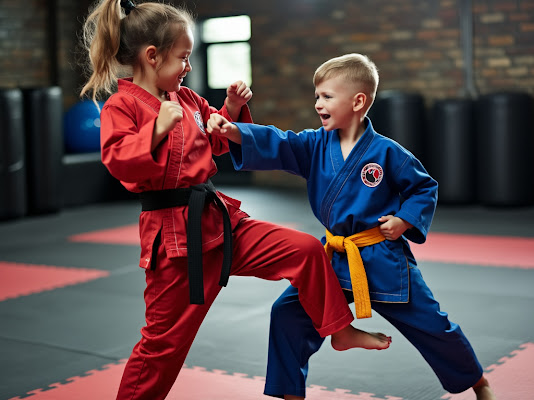Karate for Beginners

Karate, the ancient Japanese art of “empty hands,” is a journey of self-discovery and empowerment. As a beginner, you’re about to embark on a thrilling path that combines physical prowess with mental fortitude, unlocking your hidden potential and transforming your life in ways you never imagined.
Key Takeaways:
- Karate is a Japanese martial art focused on self-defense and personal growth
- Finding the right karate school is crucial for beginners
- Master fundamental techniques like stances, punches, and kicks
- Kata and kumite are essential advanced training methods
- Regular practice and respect are key to progress in karate
- Karate offers numerous physical and cognitive benefits
Discover the Art of Empty Hands: What is Karate?
Alright, karate nerds! Let’s dive into the awesome world of karate. This Japanese martial art, which literally means “empty hands,” is all about turning your body into a weapon. But don’t worry, we’re not here to hurt anyone – karate is about building confidence, respect, and avoiding conflicts.
I’ve got to give a shout-out to James Masayoshi Mitose, the mastermind behind Kosho-Ryu Karate. This style emphasizes practical self-defense and mental discipline. It’s not just about kicking butt; it’s about becoming a better version of yourself.
Your First Steps: Getting Started with Karate
Ready to jump in? Awesome! Your first move is finding the right dojo. I recommend checking out James Martial Arts Academy for adult beginners. They offer top-notch training for newbies and seasoned karatekas alike.
Before you sign up, take some time to observe a few classes. Get a feel for the atmosphere and teaching style. Most schools offer a trial class, so take advantage of that!
Once you’re in, you’ll need some gear. Here’s your karate shopping list:
- Gi (uniform)
- Belt
- Protective gear (for when you start sparring)
Remember, karate isn’t a one-and-done deal. It’s all about consistent practice. Set some short-term and long-term goals to keep yourself motivated. Trust me, you’ll be amazed at how quickly you progress!
Master the Basics: Fundamental Karate Techniques
Alright, let’s talk kihon – the basics. These are the building blocks of karate, and they’re crucial to master. We’re talking stances, punches, blocks, and kicks.
Let’s start with stances. The two you need to know right off the bat are:
- Attention Stance (Musubi-Dachi)
- Natural Stance (Shizentai)
Next up, punches. We’ve got face, chest, and stomach punches. Each has its nuances, but they all pack a serious punch (pun intended).
Blocks are your first line of defense. Focus on side blocks and upper blocks to start. These will help you deflect incoming attacks like a pro.
Finally, let’s talk kicks. The front kick (Maegeri) and knee strike (Hiza Geri) are your bread and butter. Master these, and you’ll be well on your way to building a solid foundation in karate.
Beyond the Basics: Forms and Sparring
Once you’ve got the basics down, leveling up with kata and kumite is time. Kata are pre-arranged fight sequences that help you practice techniques without a partner. They’re like a dance but way cooler (and more practical).
Kumite is where things get real. You’ll start with Ippon Kumite (one-step sparring) and work your way up to Jiyu Kumite (free sparring). It’s a gradual progression that keeps you safe while you learn.
For the advanced students, Goshi Jutsu – self-defense kata prepares you for various threats. It’s like leveling up in a video game but in real life!
Key Techniques Every Beginner Should Know
Let’s break down some essential karate moves you’ll want to master:
- Inward block: Your go-to defense move
- Backfist strike: Quick and unexpected
- Reverse punch: For maximum power
- Knee strike: Perfect for close-range combat
- Front kick: The basic kicking technique you’ll use all the time
Practice these regularly, and you’ll be impressing your sensei soon!
The Path to Mastery: Practice and Respect in Karate
Here’s the secret to karate success: practice, practice, practice! But don’t forget to stretch before and after your workouts. Your muscles will thank you.
Respect is a huge part of karate culture. Always address your instructors properly and bow when entering or leaving the dojo. It’s not just tradition – it’s about cultivating a mindset of humility and discipline.
Unlock Your Potential: Health and Cognitive Benefits of Karate
Karate isn’t just about looking cool (although that’s a nice bonus). It’s a full-body workout that improves fitness, coordination, and overall health. But the benefits don’t stop there.
Recent studies suggest that karate can strengthen neural pathways in your brain. Some researchers even think it might help with neurodegenerative diseases. So, you’re not just training your body – you’re also giving your brain a workout!
Join the Karate Community: Your Next Steps
Ready to start your karate journey? Here’s what you need to do:
- Visit James Martial Arts Academy to learn about their classes
- Schedule a trial class
- Show up with an open mind and a willingness to learn
Remember, karate is a lifelong journey. Embrace the process, enjoy the ride, and prepare to become your best version. Osu!
Sources:
James Martial Arts Academy
Kosho-Ryu Karate

